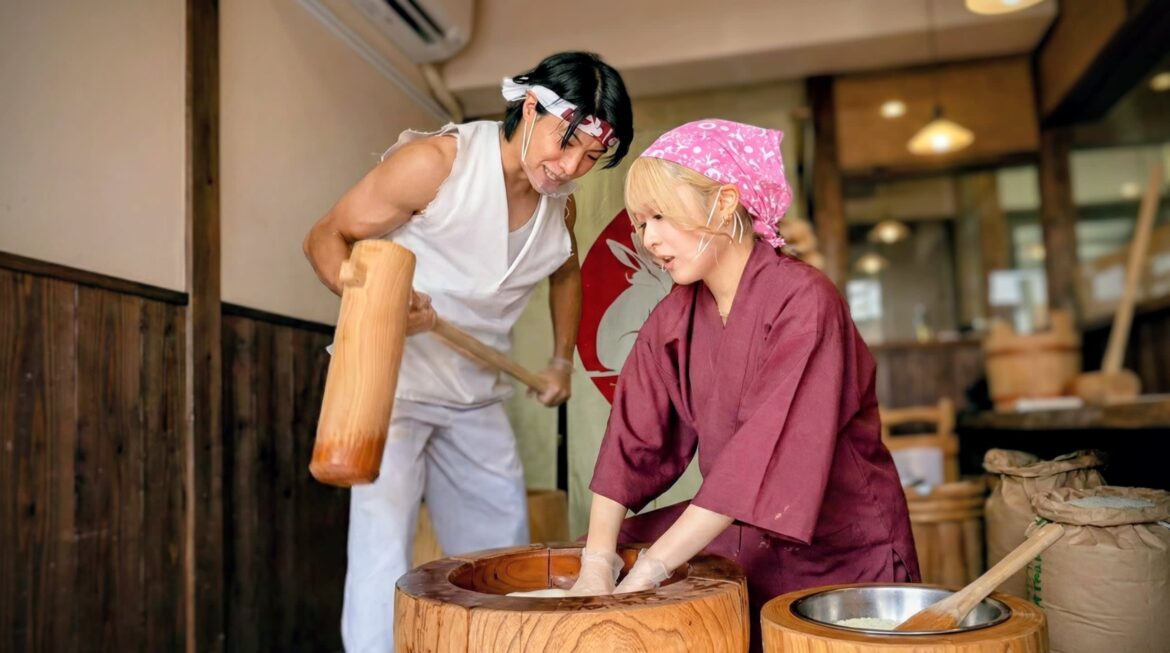Let’s be honest about how you found this. You were likely lying in bed, the blue light of your phone illuminating the dark room, your mind on autopilot as you scrolled through an endless stream of dance challenges and cooking hacks. Then, suddenly, your thumb stopped.
You were staring at a video that felt visceral, almost violent. A man, built like a tank, swinging a massive wooden mallet with bone-crushing force. Opposite him, a fearless woman dives her bare hand into the impact zone, flipping a steaming ball of white dough mere milliseconds before the hammer slams down.
Wham. Slap. Wham. Slap.
This is what the internet has dubbed the Kyoto Mochi Incident.
If you haven’t seen it, you essentially haven’t been online recently. It appears on Reddit forums dedicated to satisfying videos, on Instagram pages showcasing extreme skills, and most recently, it has taken a dark turn on TikTok, appearing in compilations of creepy or unexplained events.
But what exactly is going on here? Is this a cooking demonstration? A dangerous stunt performed for views? Or, as the darker corners of the internet claim, is it evidence of something sinister? Today, we are breaking down the viral phenomenon that turned a sweet Japanese treat into the internet’s favorite anxiety loop.
The Reality: High-Speed Tradition or a Death Wish?
First, let’s strip away the internet noise and look at the reality. What you are watching is Mochitsuki, a centuries-old Japanese ceremony traditionally performed to welcome the New Year. The goal is deceptively simple: turn hot, steamed sticky rice into mochi, a soft, elastic rice cake.
However, the chemistry of the food dictates the danger. The rice must be pounded while it is scorching hot. If the artisans move too slowly, the rice cools down, hardens, and becomes inedible. This necessity for speed gave birth to the “High-Speed Pounding” technique famously seen in cities like Nara and Kyoto.
It is a dangerous dance of absolute trust. The “Pounder”—usually the man wielding the heavy kine mallet—creates the rhythm. The “Turner”—usually the woman—provides the moisture and flips the dough. They shout to keep time. They breathe in sync. It is less like baking a cake and more like a choreographed martial art. But to the untrained eyes of the digital generation, it looks like a disaster waiting to happen.
The “Incident” That Broke the Internet
The specific video that is currently causing chaos in comment sections actually dates back several years, but it has resurfaced recently with a vengeance.
In the clip, a woman dressed in a traditional purple work outfit and a pink headscarf is serving as the turner. The speed is blinding. Suddenly, at the climax of the pounding, the hammer comes down at a terrifying angle. To the viewer, it looks like it clips her hand. Her face contorts for a split second—a mix of shock, adrenaline, and intense focus.
The internet froze on that single frame, and two distinct narratives were born.
The first was the Meme Angle. Users joked that this was the ultimate test of trust, or made dark jokes about how marriage counseling looks different in Japan. It was funny, lighthearted viral content.
But then came the Horror Angle. Recently, creators began taking this clip, slowing it down, adding distorted, low-frequency audio, and applying grainy black-and-white filters. Suddenly, a simple timing error became a “glitch in the matrix.” Narratives spun out of control, claiming the woman was trapped in a loop, forced to pound mochi for eternity, or that the video was “found footage” from a cursed shop. This reframing transformed an innocent mistake into a piece of digital folklore.
The Psychology of the Trend: Why We Can’t Look Away
Why does a video of rice pounding garner millions of views alongside movie trailers and celebrity gossip? Why does it make your heart race?
The answer lies in the Anxiety Loop. This video triggers a primal fear response in the human brain. Every time that heavy wooden hammer swings upward, your brain flinches. You are subconsciously waiting for the accident. You aren’t watching for the success of the mochi; you are watching because of the potential for pain. It is the same psychological hook that keeps people glued to car racing—not for the driving, but for the potential crash.
Furthermore, the skill displayed is so extreme that it enters the Uncanny Valley. When humans move with machine-like precision, appearing almost robotic in their efficiency, it fascinates and terrifies us simultaneously. We wonder if they are in a trance, or if they have lost their free will to the rhythm of the hammer.
The Verdict: A Masterpiece of Trust
The Kyoto Mochi Incident isn’t a ghost story, and it isn’t a crime scene. It is a testament to human skill and the intense pressure of preserving tradition. The woman in the purple outfit didn’t lose her hand; in reality, she likely laughed off the near-miss and went back to work five seconds later.
But the internet has a way of twisting reality. It took a moment of cultural celebration and turned it into a global conversation about trust, danger, and fear.
So, the next time this video loops on your screen, don’t just wait for the accident. Watch the woman’s eyes. That isn’t fear you are seeing—it is the intense, laser-focused power of a master at work.
Though, perhaps, it is best not to try this particular recipe in your own kitchen.


AloJapan.com